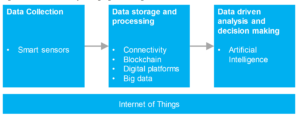The combined development of different emerging technologies (e.g. smart sensors, blockchain, artificial intelligence) boosts innovations in smart mobility. The increasing pressure on achieving societal goals within the transport sector (e.g. decarbonization, improving traffic safety, reducing congestion) will be another driver for smart mobility. TNO and CE Delft report about it.
There are still many challenges implementing smart mobility applications in a way that maximizes the benefits for Europe and at the same time minimizes negative impacts. Lack of harmonization in national legislation and lack of social acceptance are just two examples of issues that may hamper their large-scale deployment. The report presents many examples from the logistics industry and the impact of smart mobility in transport companies.
The study provides an overview of the most relevant smart mobility applications and their underlying emerging technologies for all transport modes (road, rail, shipping, and aviation) for the period up to 2030. Their impacts on the transport system and society are assessed. Additionally, the main challenges for their development and deployment are identified, and actions that could be taken to address these challenges are discussed.
The level of maturity of the various emerging technologies varies greatly. Some are already widely applied (e.g. smart sensors, connectivity technologies), although further development is expected in the next decade. Other technologies (e.g. Artificial Intelligence) are potentially ground-breaking, but applications are only just starting to use them, discovering what is already possible and what still needs to be developed.
Promising technologies
The emerging technologies are key drivers of developments in smart mobility applications. The most promising are:
- Cooperative Intelligent Transport Systems (C-ITS) are applications where Intelligent Transport Systems (e.g. vehicles, infrastructure equipment, traffic control centers) communicate and share information in order to improve road safety, traffic efficiency, sustainability, etc.
- Connected Cooperative Automated Mobility (CCAM) comprises different levels of assisted and automated driving. It ranges from driver assisting features like automated cruise control to fully automated vehicles.
- Mobility as a Service (MaaS) is the integration of various forms of transport services into a single mobility service accessible on demand. It offers transport users access to plan, book, and pay for a range of transport services, which can be easily accessed by an app.
- Self-organising Logistics (SoL) refers to decentral coordination of logistic chains, meaning that individual agents in the chain (e.g. companies, vehicles, containers) make autonomous decisions based on local intelligence and local data.
Impacts on transport and society
Smart mobility applications are expected to provide significant benefits for transport users, particularly by increasing transport efficiency (e.g. more flexibility) and improving travel experience (e.g. higher feeling of comfort). Smart mobility applications may also have the potential to significantly contribute to the achievement of societal goals, like less CO2 emissions, improved traffic safety, and less congestion.
Especially jobs in the transportation and logistics sector are at risk of being replaced by automation in the coming decades. Self-organizing logistics has the potential to improve the efficiency of logistical processes. Current system operators calculate the optimum route for freight and packages and can deliver a track-and-trace system. Cooperative actions through digitalization in sharing warehousing and transport capacities has the potential to improve the efficiency and reliability of the logistics industry. Self-organizing logistics can also be self-learning (using predictive analyses and machine learning), where processes are optimized through harvesting data from current and historical data.
To what extent this potential will be materialized depends on its design and management by public authorities (with actions such as legislation, funding, piloting, and public-private cooperation). If not managed well, smart mobility applications’ contribution to achieving societal goals will be less prominent and may be even negative (e.g. if the additional transport demand expected to be generated by CCAM is not managed well, it may result in additional emissions which may undo any emission reduction at the vehicle level, ending up with higher total emissions levels).
The full impact of smart mobility will only be realized in the long-term. First, because most applications need a critical mass to become fully effective. Secondly, because smart mobility applications become more effective in the next decade due to technological improvements. Finally, the evidence on the impacts of smart mobility applications is only available from small-scale pilots, scenario studies, and stated preferences studies. Therefore, the uncertainty in these findings is high. Authorities play an important role in public-private partnerships.
Source: TNO

